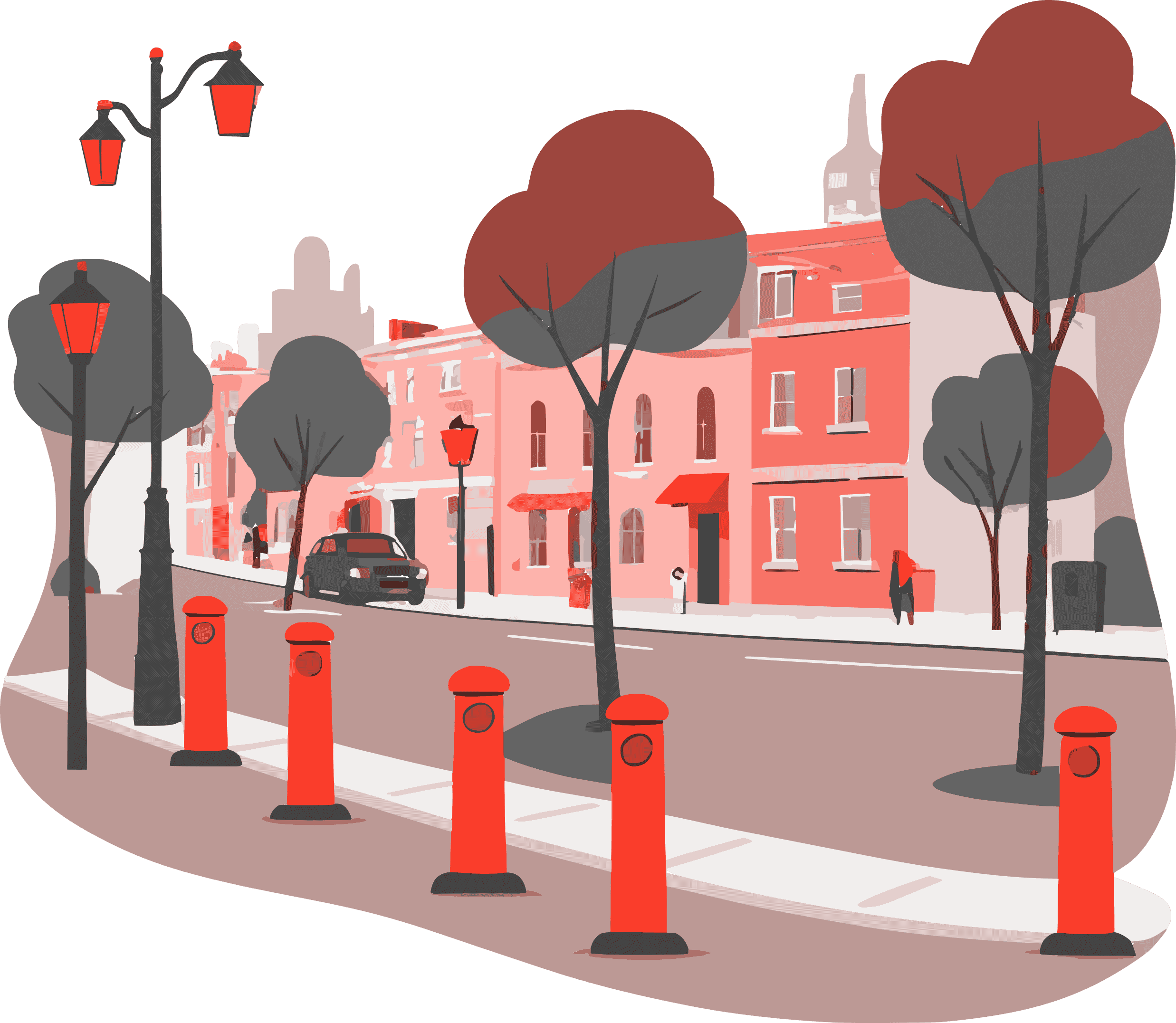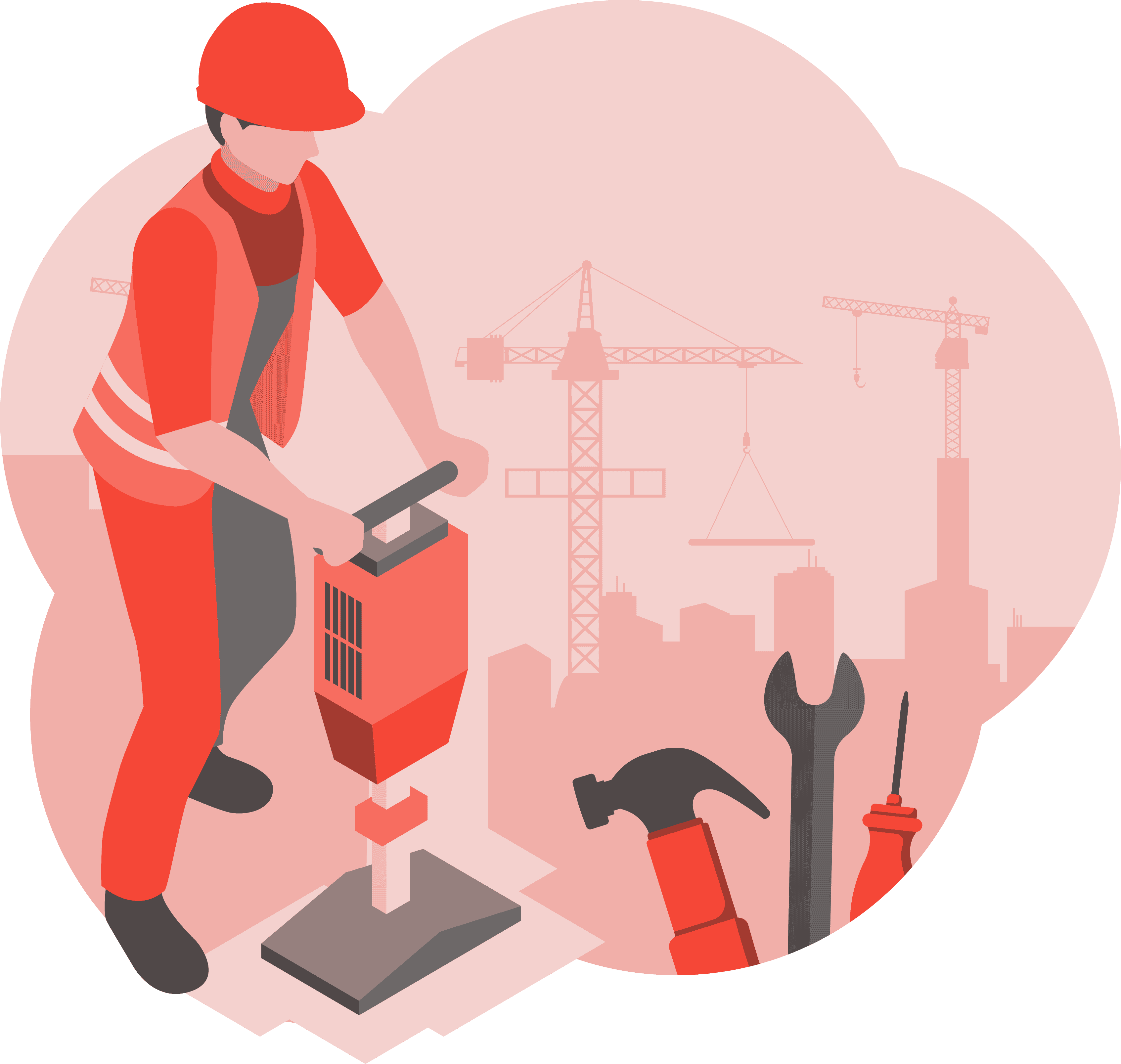
The Ultimate Guide to Bollards & Parking Posts
1. Introduction
Introduction
Bollards are everywhere around us and serve many purposes across the landscape, from traffic management and pedestrian safety to security and simply aesthetic enhancement. They are sturdy, vertical posts designed to provide physical and visual barriers and are typically installed along streets, parking lots, public spaces, and buildings. Bollards help control access, define boundaries, and prevent accidental or intentional vehicle intrusions.
Historically, bollards started as simple wooden or metal posts used to moor ships along docks. Over time, their function changed to include urban planning and security applications. Today, bollards come in many forms, including fixed, retractable, and flexible designs, and can be made from materials such as steel, concrete, plastic, and even recycled materials. Their design varies depending on their intended use—some are purely functional, while others incorporate decorative elements to blend seamlessly with architectural and landscape aesthetics.
With urban areas facing increasing concerns over pedestrian safety and vehicle-related incidents, bollards play a crucial role in modern infrastructure. Whether protecting storefronts from accidental crashes, guiding traffic in congested areas, or securing government buildings from potential threats, bollards provide an effective and often visually appealing solution for managing spaces and ensuring public safety.
2. What Are Bollards Used For?

Bollards serve multiple functions, from enhancing safety, including pedestrian protection, traffic management, and perimeter security, to improving urban aesthetics. Their versatility makes them essential in both public and private spaces, ensuring protection and organisation without obstructing movement.
Pedestrian Safety
Bollards create a protective barrier between vehicles and pedestrian areas. This is probably one of the most popular reasons for installing them, as they reduce the risk of accidents in busy environments. Bollards are usually lined along sidewalks near schools, parks, and shopping centres to separate traffic from people. They help define safe walking zones and prevent unauthorised vehicle access, ensuring a safer environment for anyone on foot.
Traffic Management
Another widespread use for bollards is to guide and control traffic flow. This can be required in various places, such as streets, car parks, and restricted zones. They help separate lanes, indicate no-entry areas, and prevent vehicles from making dangerous turns or encroaching on pedestrian crossings or bike lanes. Some types of bollards, like flexible or removable ones, are indispensable in these use cases as they allow for adaptable traffic control, depending on the needs of the space.
Building & Infrastructure Protection
Security bollards are placed around critical infrastructure, such as government buildings, power stations, and commercial properties, to prevent accidental or intentional vehicle collisions. They are also used as anti-terrorist and ram-raiding protection. In high-risk areas, impact-resistant bollards protect storefronts, gas stations, and financial institutions from intentional or accidental vehicle attacks.
Perimeter Security
As part of broader security strategies, bollards are installed around properties, event spaces, and sensitive locations to prevent unauthorised vehicle entry. They are often used in combination with fencing, gates, and surveillance systems to create controlled access points while allowing free pedestrian movement. This makes them convenient and unobtrusive while being efficient and protective.
Aesthetic and Decorative Uses
Beyond their functional roles, bollards contribute to the overall design of urban landscapes. Decorative bollards complement streets, squares, and historic districts, blending into architectural themes while maintaining security and order. These bollards can also incorporate lighting elements, signage, or branding to enhance visibility and fit a certain style.
3. What Are the Different Types of Bollards
Bollards come in different shapes, sizes, and features. Different types can be strategically deployed to achieve specific goals.
Fixed Bollards
One of the most common types is permanent or fixed bollards. They are cylindrical posts of varied heights that become non-removable once installed into the ground. Unlike removable bollards, they are permanently anchored and cannot be relocated.
Fixed bollards are typically used for security, traffic and parking management and control, and pedestrian protection from vehicles. This is why they are usually made of materials like steel and concrete, which provide long-term protection, a long life, and very good resistance to impact.
They are the most practical solution for places where you don’t anticipate changing traffic needs, like shopfronts, along pedestrian areas, and so on, which will likely need protection permanently. This is because, once installed, they’re not easy to remove and because the permanent anchoring gives them more durability and better resistance to impact.
Removable Bollards
Removable bollards, as their name suggests, are traffic barriers which, once installed, can easily be removed when they aren’t needed. Just like the fixed ones, they can be of different sizes and heights. The fundamental difference between the two models is that they are usually installed into the ground with a sleeve which the bollard itself can slide in and out of. When needed, they can be erected and locked in place by a locking mechanism or a special base plate. They can be unlocked, taken out of the sleeve, and stored away until the next time they are needed.
Removable bollards are a great traffic tool to have at your disposal due to their flexibility and the freedom they give you to make temporary changes. You can see them used in areas where temporary access needs to be given or restricted indoors and outdoors. They are ideal for city centres where you may want to close off streets for festivals or alternatively open up pedestrian areas for vehicles if needed. These bollards are also helpful around loading bays and so on.
They have two main disadvantages. One is that when not in use, they need to be stored somewhere, which may add an extra step to any logistics and must be planned for. The other one is that, even though they are tough and offer good protection, they are not anchored permanently to the ground like fixed bollards, which does somewhat affect their resistance to impact and they can be dislodged more easily.
Retractable & Telescopic Bollards
Retractable or telescopic bollards are another variety of removable bollards with one key difference. They eliminate one of the disadvantages we highlighted about removable bollards—storage needs. Telescopic bollards are also designed with a sleeve but the sleeve (or socket) is made to house the whole bollard itself. They are manufactured to completely retract into the ground when not in use. This can be done by either manual lifting and lowering or with a hydraulic mechanism that does the heavy lifting for you.
This main difference makes them very convenient and easier to use. They also perform a bit better in terms of security as they aren’t so susceptible to tampering or unauthorised removal and are anchored to the ground at all times, giving them more resistance to impact. As for use cases, retractable bollards have similar applications to removable ones while offering fewer complications.
Flexible Bollards
Flexible bollards are specially designed posts that bend or flex upon impact rather than remaining rigid like traditional bollards. They are commonly used in areas where vehicles may occasionally make contact with them, such as parking lots, bike lanes, and roadways. These bollards help control traffic and enhance safety while minimising damage to vehicles and infrastructure.
One of their best features is that they are vert impact-resistant as they are made from materials like polyurethane, rubber, or composite plastics, allowing them to bend and return to their original shape after impact. Flexible bollards are also often designed in brighter colours or have reflectors that make them very visible, even in low-light conditions. This, of course, depends on the model you choose, but it is often an option. Due to the materials they’re manufactured from, flexible bollards are very durable, making them a suitable choice as they are resistant to weather, UV rays, and wear from repeated impacts. Lastly, we would highlight that they are easy to maintain and don’t need replacing after minor collisions.
These bollards are an effective solution for areas where maintaining traffic control is essential, but the risk of vehicle impact is high. They balance safety and practicality by preventing permanent damage while still acting as a strong visual deterrent. This makes them suitable for car parks, pedestrian or bike lanes, and roads.
Automatic Bollards
Automatic bollards are retractable bollards specifically made with motorised or hydraulically operated posts that can be raised or lowered as needed to control vehicle access in specific areas. Unlike fixed bollards, which remain in place permanently, automatic bollards provide a dynamic security and traffic management solution, making them ideal for locations requiring controlled or temporary access.
These models are great because they are usually remote-operated and can be controlled with a transmitter, making them very convenient. Their mechanisms also eliminate the need to do any heavy lifting yourself. High-quality models have high crash resistance and can work well even in extreme weather conditions.
Automatic bollards offer a flexible and high-security solution for areas that require regulated vehicle access while maintaining an unobtrusive and aesthetically pleasing streetscape. They are used around high-security facilities, pedestrian areas, and even private properties.
Heavy Duty Bollards
Heavy-duty and ram-resistant bollards are high-strength security barriers designed to stop or mitigate the impact of high-speed vehicle ramming attacks. These bollards are commonly used in areas that require maximum protection against unauthorised vehicle entry, such as government buildings, military bases, embassies, financial institutions, and pedestrian zones at risk of vehicular attacks.
They have high impact resistance and are made to withstand collisions with vehicles. Typically made from steel or reinforced with concrete they are manufactured to protect from direct impact. Some models are permanent, while others can be retractable for more controlled access. They are often used around banks, shopping centres, jewellers or ATMs to prevent ram-raiding and other critical high-security buildings like airports, power plants, etc. These bollards serve as a critical defence measure, preventing vehicle-based attacks while allowing safe pedestrian movement and maintaining a secure environment.
Decorative Bollards
Lastly, bollards are often used simply for decorative purposes or as a demarcating line between areas. These types of bollards may provide some protection, but their primary purpose is not security. They can be made of varied materials, including wood, which is a great choice for parks and other nature areas.
4. What Are the Most Common Materials Used in Bollard Construction

When selecting bollards, you need to consider your needs and the purpose they will be expected to serve. Different materials may also be better suited to different environments, which should be kept in mind—wood may work well in a rural park, while stainless steel can be indispensable on a busy city street.
Steel and Stainless Steel Bollards
Steel remains one of the most commonly utilised materials in the manufacturing of street furniture—and for good reason. Its durability, versatility, and ease of fabrication make it a reliable choice across a wide range of applications. The performance of steel products can be further enhanced through galvanisation or by selecting stainless steel variants.
Galvanisation involves applying a protective layer of zinc to the surface of the steel, significantly increasing its resistance to rust and extending the material’s lifespan. In addition to its enhanced corrosion and impact resistance, galvanised steel can be powder-coated, offering a variety of finishes and colour options. These qualities make it especially well-suited for high-traffic areas, where long-lasting, resilient products are essential.
Stainless steel is another widely preferred material, particularly for products such as bollards. Known for its sleek appearance and exceptional resistance to rust and corrosion, stainless steel offers both aesthetic appeal and performance. The most commonly used grades in this context are 304 and 316. Grade 304 provides excellent all-around performance for general applications, while grade 316, with its superior corrosion resistance, is ideal for environments exposed to saltwater or harsh weather conditions. Its strength, durability, and low maintenance requirements make stainless steel an excellent choice where both visual appeal and long-term reliability are priorities.
Concrete Bollards
Concrete bollards are another interesting choice in the realm of protective street furniture. Typically constructed from reinforced or precast concrete, they offer a distinctive combination of visual appeal and robust functionality. Concrete’s high compressive strength provides excellent impact resistance, making these bollards highly effective in mitigating collisions.
When reinforced with internal steel elements, concrete bollards gain additional structural integrity, reducing the likelihood of cracking and enhancing overall durability. Another significant advantage is their inherent resistance to weathering and corrosion, which contributes to minimal maintenance requirements over time.
Thanks to these qualities, concrete bollards are widely favoured for safeguarding buildings, infrastructure, and pedestrian zones across diverse environments.
Rubber Bollards
While less common than their metal counterparts, rubber bollards are an excellent solution for specific traffic management needs. Typically manufactured from vulcanised granulated rubber reinforced with polyester fibres—often sourced from recycled materials—rubber bollards are both environmentally conscious and highly functional.
These bollards offer a unique combination of strength, flexibility, and resilience. Designed to withstand low-speed impacts, rubber bollards can flex upon contact without sustaining damage, making them ideal for areas where occasional collisions may occur, such as car parks, loading zones, or shared pedestrian and vehicle pathways.
Their flexibility not only prevents damage to vehicles and the bollards themselves but also significantly reduces the need for maintenance or replacement. However, it’s important to note that their impact resistance is most effective in lower-speed environments. As such, careful consideration should be given to the specific conditions and requirements of each installation site to ensure the most appropriate material choice.
Recycled Plastic Bollards
Recycled plastic bollards are strong, flexible, and light. They have good impact resistance and don’t rot, corrode, or fade, which gives them a low-maintenance advantage over metal models. They are suitable for many areas where traffic management is needed, such as parks, pedestrian areas, traffic calming, and industrial and commercial sites.
Polyurethane Bollards
Polyurethane bollards offer a lightweight yet highly durable solution for traffic control and pedestrian safety. Known for their excellent abrasion resistance and resilience against corrosion and extreme weather conditions, these bollards require minimal maintenance over time.
Many polyurethane bollards are designed with flexible properties, allowing them to absorb impact and return to their original shape without compromising structural integrity. This makes them particularly suitable for environments where low-speed vehicle contact may occur, such as car parks, warehouse perimeters, or shared-use spaces.
Similar to rubber bollards, polyurethane variants are ideal for moderating vehicle movement while minimising the risk of damage to both vehicles and infrastructure. Their ability to endure repeated impacts without loss of performance makes them a practical and cost-effective choice for high-traffic yet low-impact environments.
Cast Iron
Cast iron bollards are perfect for heritage sites and places looking for a certain aesthetic. They are the traditional choice and are often moulded into interesting decorative designs. These beautiful pieces can add character to a location and provide some traffic guidance and demarcation. However, they are a bit temperamental and require a bit more care to prevent rust and chipping and keep them in good condition.
5. How to Choose the Right Bollard for Your Needs
Selecting the right bollard depends on its intended function, the level of protection required, and the surrounding environment. As we mentioned above when discussing materials, when deciding what to buy, you need to consider where it will go and what it needs to do.
This needs to be your main starting point. Are you using the bollard primarily to provide pedestrian safety or to control and guide traffic? Do you need it to protect your property, and is security a top priority? Or will the bollards mainly function as decorative pieces to complement your surroundings? Are your needs likely to stay the same for a long time, or will the space require some flexibility?
Depending on the answers to these questions, you may need to select very different bollards. Pedestrian safety at high traffic zones where higher speed is possible will require sturdy bollards which can take on a collision and safeguard the people on the sidewalk, like our fixed stainless steel or steel selection or some of our flexible bollards. However, if we are talking about a low-speed zone where impact is likely to be slower and less damaging to people, you may also opt for rubber and flexible bollards, which will demarcate the lines between pedestrians and traffic, protect the people on foot and prevent any damage to the vehicle.
On the other hand, if traffic control is your primary concern and you need to guide vehicles along a certain path or restrict access to some areas, then you might want to look at permanent bollards. These can protect your property, guide cars, and keep traffic from mixing or going the wrong way. For areas where there might be temporary needs, you can restrict access with removable bollards.
If your primary concerns are security and ram raids, then look at heavy-duty bollards, which are designed to stop or at least slow down vehicles on a collision course—accidental or not. These models are reinforced and are typically permanent installations, which allows them to take on a stronger impact.
If you’re going after a specific look, you might select decorative bollards that complement your aesthetic. These can be cast iron ones that hint at old times and are perfect for historic settings, or you can go for stainless steel, which can be both secure and have that specific shiny modern look.
When selecting your bollards, you need to know what you want them to do and, as mentioned above, when you want them to do it. So think about how permanent your needs will be in all cases. If you don’t anticipate any changes in the use of the space, we recommend going for a permanent option – they give you more protection once installed, require no attention, except for the occasional maintenance check. However, if you expect to need to move the bollards occasionally, you should probably consider removable and retractable options.
Something else to consider is their visibility. Some models are designed to be high-visibility and to work well even in low-light environments. They can be useful in car parks, roads, and anywhere it might get dark and no artificial light is available. This requirement might not be essential for every use case, but it is worth considering.
Lastly, when we discussed materials for each, we briefly mentioned its maintenance needs. This may be something that plays a part in your decision, as some models require regular maintenance while others require virtually no upkeep. As we said about rubber and polyurethane bollards, they are of the latter type. They often come pre-coloured, which removes any need to repaint them, and are immune to rot, rust and corrosion, which makes them long-lived regardless of the elements to which they are exposed outdoors. On the other hand, iron needs repainting and may rust if not appropriately protected. Galvanised steel and stainless steel have excellent corrosion resistance properties but, over time, will need some maintenance. Fixed bollards require less care due to the lack of moving elements, while retractable ones need regular checks on their mechanism for lowering and locking to ensure they work properly.
Choosing the right bollard involves balancing functionality, security, aesthetics, and maintenance. Whether you need bollards for pedestrian protection, traffic management, or high-security applications, understanding these factors ensures you select the best option for your specific needs.
6. Bollard Installation: Best Practices

Proper installation is critical to ensuring that bollards perform their intended function—especially when they are used for safety, security, or property protection. Poor installation can significantly compromise effectiveness, regardless of the bollard type. To help you get it right, we’ve outlined some essential tips to guide your installation process.
Before diving into the specifics of various bollard types, there are several universal steps you should take—regardless of the model you’re installing. If your bollards are supplied with manufacturer-specific installation instructions, always prioritise those. In the absence of such documentation, the following general guidelines can serve as a reliable reference.
Start by thoroughly inspecting the intended installation site. Review any existing plans or schematics to understand the layout and constraints of the area. One of the most critical aspects of this step is identifying the type of surface you'll be working with—whether it’s soil, concrete, tarmac, or something else — as this will influence the fixing method required.
Equally important is determining the presence of any underground utilities. Drilling without this knowledge poses significant safety risks and could render certain installation methods unfeasible. In cases where deep installation is not an option due to underground infrastructure, you may be limited to surface-mounted or bolt-down bollards fixed to existing concrete bases.
Carrying out a thorough assessment beforehand helps avoid costly errors and ensures that the chosen installation method is both safe and effective.
How to Install Fixed Bollards
Most fixed bollard models can be selected with flanged or ragged fixings. Ragged bollards typically have a spiked ending that needs to be anchored and cast in concrete. Flanged fixings, on the other hand, are to be bolted down onto an existing surface with a few bolts. They are a good option if utilities are running under the installation site.
For ragged bollards:
- You can start by marking your location and the hole size.
- Dig a hole based on the bollard’s specifications, typically a little deeper than the specified below-ground height and wide enough for a cube shape slightly larger than the bollard’s circumference.
- Then place the bollard into the hole and make sure it is levelled.
- Pour the concrete into the hole around the bollard and check if it’s secure, stable and level again before allowing it to cure.
For flanged bollards:
- Mark your installation site while also making sure it’s level and clean.
- Position the bollard where you want it and use the correct bolts to secure it to the ground.
How to Install Removable Bollards
Installing removable bollards starts with the same site assessment as any other bollard. Once you’ve done that, you can:
- Mark your exact location.
- Dig a hole that’s deep and wide enough to accommodate the bollard’s ground sleeve (typically 300mm–600mm deep and 200mm–300mm in diameter).
- To ensure drainage at the bottom of the hole, some gravel or drainage aggregate must be added.
- Put the sleeve into the hole and pay attention to its top – it needs to be exactly at ground level for a smooth surface once the installation is finished.
- Mix and pour the concrete around the sleeve, keeping it stable. Make sure it’s fully covered, and its interior is clear of concrete and debris.
- Allow the concrete to cure for 24-48 hours.
- Once the concrete is set, place the bollard in the sleeve, lock it, and test if it can be easily removed and reinserted.
How to Install Collapsible Bollards
Telescopic bollards should be installed with the utmost care. They require careful planning and precision to ensure stability and good function.
- Choose your spot and mark it.
- Dig a hole deep enough to accommodate the bollard’s casting, typically 800mm–1200mm deep, but follow the manufacturer’s instructions carefully. For automatic bollards, that may need to be a little deeper. The hole must also be wide enough to provide stability – generally at least 300mm - 500mm in diameter.
- To ensure drainage at the bottom of the hole, some gravel or drainage aggregate must be added.
- Insert the bollard’s sleeve into the hole and ensure it is level and the bollard is standing straight.
- Mix and pour the concrete around the casing, making sure there are no gaps left. Make sure it’s fully covered, and its interior is clear of concrete and debris.
- Allow the concrete to cure for 24-48 hours.
- Once the concrete is set, place the bollard in the sleeve and test the lifting and locking mechanisms.
7. Maintenance of Bollards

Proper maintenance ensures that bollards remain functional, durable, and visually appealing over time. Whether they are retractable, removable, or fixed, regular upkeep can prevent mechanical issues and extend their lifespan.
Keep Bollard Sockets and Casings Clean
As with anything else you install on your property, regularly removing dirt, debris, and leaves is generally a good place to start for maintenance. The sleeves of removable and retractable bollards should be paid extra attention to. You don’t want any buildup gathering inside the mechanisms that could obstruct movement.
Lubricate and Inspect Parts
Again, this advice doesn’t really apply to fixed bollards, which are probably the easiest to maintain but rather retractable and removable ones. It is good practice to apply lubricant to their moving parts occasionally. Mechanisms should be taken care of to ensure they operate smoothly and prevent stiffness. Locks and fastenings should also be regularly checked. If they’re not working properly and are damaged, your bollards won’t be doing their job.
Check for Rust or Corrosion
This advice applies to all bollards, with the exception of ones made of materials that don’t rust, like concrete and rubber. Steel and iron, however, may require occasional rust-resistant coatings to maintain their durability over the years. Galvanised steel bollards will take a very long time to rust, but if they get damaged by an impact and larger scratches and dents develop, the process may speed up. The solution to that is to check them regularly for any signs of damage and react timely.
Meanwhile, stainless steel will likely not rust any time soon, but it isn’t immune to rust if exposed to harsh chemicals, salt, or prolonged moisture without good airflow. This is why it’s important to clean it with non-corrosive solutions and ensure good drainage. For removable and retractable bollards, it is worth checking regularly for clogged drainage holes and sleeves and clearing them out when you see an issue developing.
Conduct Regular Structural Inspections
Lastly, as a basic maintenance tip, we would add that it’s always good practice to include bollards on your property in your inspections. Occasionally, examine bollards for cracks, dents, or structural damage, especially in high-impact zones where you may not have noticed an incident occurring. If you notice a bollard is damaged during one of these checks, make sure to act timely and replace or repair it to maintain safety and effectiveness.
8. Final Words
Bollards are an essential and invaluable tool in modern security and traffic management. They are indispensable when it comes to protecting pedestrians, buildings and vehicles across various settings and scenarios, and they have proven their worth on our streets. Bollards of various kinds are used on our roads and car parks and in public, private, commercial, and residential settings. There is a great variety of models and types on the market, and we know it can sometimes be challenging to decide which is best to suit your needs. We hope our guide has cleared up some differences, the pros and cons of the different types and what you need to think about before choosing one. Our blog has more articles on the topic, and they are worth reading if you want to learn more. You can also always contact us to discuss your specific needs, and we are more than happy to consult you on the best solutions.